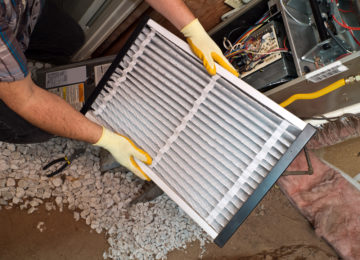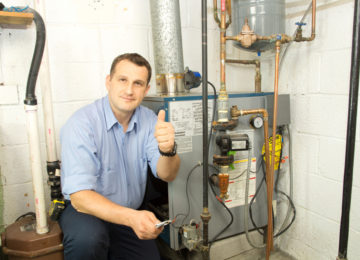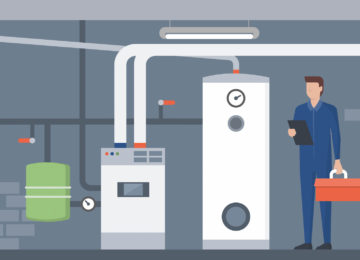The importance of home indoor air quality simply cannot be overstated. According to the National Human Activity Pattern Survey conducted between 1992 and 1994, the two-year study found that people spent nearly 90 percent of their time indoors. This staggering statistic reveals the extent of the risk that people face if they do not pay attention to the air quality in their homes.
As technological improvements become more prominent in our daily lives, it is certainly no stretch of the imagination to realize that the incentives to remain indoors are seemingly endless: heating and air conditioning, entertainment systems, and a number of other comforts and luxuries. As technology continues to evolve, it can be reasonably inferred that the amount of time spent indoors will only increase.
Health Consequences of Poor Quality Air
Polluted air in the home environment is a dangerous and can negatively impact your entire family’s health. Pollutants can cause a number of immediate and uncomfortable health problems, including headaches, eye irritation, dizziness, allergies, and fatigue. More serious concerns include the causation or exacerbation of acute and chronic respiratory conditions, such as pneumonia and asthma.
The most serious complications can occur over long-term exposure to indoor air pollution; examples of these complications include lung cancer, heart disease, stroke, and other serious respiratory conditions. Additionally, home air pollutants are associated with an increased risk of adverse health effects in pregnant women. Over time and in extreme cases, the consequences of poor-quality air in your home can be fatal.
Choosing a Healthier Life
The importance of indoor air quality is a popular topic in the United States today. Several state and local governments are taking action to ensure indoor air quality at public establishments, such as restaurants and bars. The trend toward improving air quality exists for good reason: Improving the quality of air in one’s home can improve his or her health immediately and over time.
Although the facts presented by research on home indoor air quality seem intimidating, you have the power to influence and change the factors that contribute to air pollution in your home. Education is key to understanding the risks and combating them with strategic approaches.
It is essential not only to recognize the importance of home indoor air quality but also to understand the strategies that can be utilized in order to decrease the risk of exposure to harmful air contaminants and improve the air quality of your home. The next section outlines three strategies that you can utilize to start making immediate improvements to the quality of air in your home.
Strategies to Improve Air Quality in Your Home
1. Reduce individual sources of air contaminants.
While some sources of contaminants can seem obvious, others can be elusive. An obvious source of air contamination is asbestos. Some older structures were built using asbestos insulation. Asbestos poses a problem when it is exposed. Some sources containing asbestos can be sealed, enclosed, or removed by a professional in order to reduce the air contaminants.
Other sources of contaminants that are more common and less obvious include new carpets, new electronics and other plastic devices, cleaning products, and air fresheners. Each of these items can release poisonous chemicals or volatile organic compounds that are harmful when breathed in.
It is evident that we cannot live without the majority of the previously mentioned items. Therefore, it is unrealistic to attempt to cut them out of your life completely. The best solution to reducing the air contaminants released by carpets and is to air them out as much as possible before installing them. Once new carpets are installed, open windows when weather permits to lower the exposure to the air pollutants in the home.
After installing electronic devices, increase ventilation to the area as much as possible until the odor disappears; vacuum around them frequently. To reduce contaminants from air fresheners and cleaning products, substitute harsh chemicals for more natural options.
2. Improve ventilation throughout your home.
One of the best practices to reduce air contaminants from your home is to increase the amount of outdoor air that flows into your home. The ventilation of outdoor air pushes out the contaminants that accumulate indoors.
The most effective method for improving ventilation in your home is to open doors, windows, and operable skylights. This is not always possible or realistic due to weather conditions, but it is the most effective approach that should be utilized when weather permits.
Home ventilation is absolutely crucial during short-term activities that generate high amounts of air pollutants. These activities include painting, heating with kerosene heaters, cooking, and maintenance activities, such as sanding or welding.
When possible, conduct these activities outside in order to eliminate the risk of added air contaminants. If the activity must be done inside, such as painting, only complete the activity when weather permits and allows you to properly ventilate your home.
3. Utilize air cleaners to reduce pollutants.
Air cleaners can be one of the most practical ways to ensure that the air in your home is being cleaned. While it is easy to decide that you want an air cleaner in your home, the amount of choices can be overwhelming; it can be difficult to decide on which type of air cleaner is the best fit to your home and most tailored to your home’s unique environment. Contact a TemperaturePro® North Atlanta professional for advice on choosing the best air cleaner for your home.
It is important to understand that while air cleaners are excellent at removing air particles, many are not designed to remove gaseous pollutants. Currently, the Environmental Protection Agency does not recommend using an air cleaner alone to remove the gaseous air pollutants because air cleaners are most often not designed to filter the gaseous pollutants.
However, this does not refute the air cleaner’s ability to reduce toxins in the air at home. Not all toxins are gaseous, and the other toxins are filtered out by a high-quality air cleaner. The homeowner must take the additional steps outlined in this post in conjunction with the use of an air cleaner in order to reduce and remove the presence of gaseous and non-gaseous air pollutants to improve indoor air quality.
A Healthier, Happier Home
The combination of monitoring and controlling contaminant sources, improving home ventilation, and utilizing a good-quality air cleaner creates the ideal conditions for reducing your risk associated with exposure to air pollutants in your home. By following these three simple strategies to improving your home indoor air quality, you can create an environment that is safe from even the most elusive threat that exists in something as simple as the air we breathe.
Breathe Even Easier With TemperaturePro
Interested in learning more about how to improve the quality of the air in your home? Contact a TemperaturePro® North Atlanta professional today to learn how to continue breathing easy in your home for years to come.




